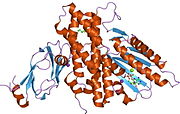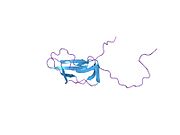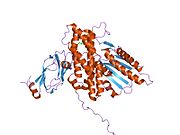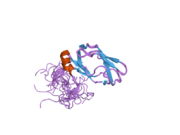| DLAT | |||||||||||||||||||||||||||||||||||||||||||||||||||
|---|---|---|---|---|---|---|---|---|---|---|---|---|---|---|---|---|---|---|---|---|---|---|---|---|---|---|---|---|---|---|---|---|---|---|---|---|---|---|---|---|---|---|---|---|---|---|---|---|---|---|---|
 | |||||||||||||||||||||||||||||||||||||||||||||||||||
| |||||||||||||||||||||||||||||||||||||||||||||||||||
| Identifiers | |||||||||||||||||||||||||||||||||||||||||||||||||||
| Aliases | DLAT, DLTA, PDC-E2, PDCE2, dihydrolipoamide S-acetyltransferase, Dihydrolipoyl transacetylase, E2 | ||||||||||||||||||||||||||||||||||||||||||||||||||
| External IDs | OMIM: 608770; MGI: 2385311; HomoloGene: 6814; GeneCards: DLAT; OMA:DLAT - orthologs | ||||||||||||||||||||||||||||||||||||||||||||||||||
| |||||||||||||||||||||||||||||||||||||||||||||||||||
| |||||||||||||||||||||||||||||||||||||||||||||||||||
| |||||||||||||||||||||||||||||||||||||||||||||||||||
| |||||||||||||||||||||||||||||||||||||||||||||||||||
| |||||||||||||||||||||||||||||||||||||||||||||||||||
| Wikidata | |||||||||||||||||||||||||||||||||||||||||||||||||||
| |||||||||||||||||||||||||||||||||||||||||||||||||||
Dihydrolipoyl transacetylase (or dihydrolipoamide acetyltransferase) is an enzyme component of the multienzyme pyruvate dehydrogenase complex. The pyruvate dehydrogenase complex is responsible for the pyruvate decarboxylation step that links glycolysis to the citric acid cycle. This involves the transformation of pyruvate from glycolysis into acetyl-CoA which is then used in the citric acid cycle to carry out cellular respiration.
There are three different enzyme components in the pyruvate dehydrogenase complex. Pyruvate dehydrogenase (EC 1.2.4.1) is responsible for the oxidation of pyruvate, dihydrolipoyl transacetylase (this enzyme; EC 2.3.1.12) transfers the acetyl group to coenzyme A (CoA), and dihydrolipoyl dehydrogenase (EC 1.8.1.4) regenerates the lipoamide. Because dihydrolipoyl transacetylase is the second of the three enzyme components participating in the reaction mechanism for conversion of pyruvate into acetyl CoA, it is sometimes referred to as E2.
In humans, dihydrolipoyl transacetylase enzymatic activity resides in the pyruvate dehydrogenase complex component E2 (PDCE2) that is encoded by the DLAT (dihydrolipoamide S-acetyltransferase) gene.
Nomenclature
The systematic name of this enzyme class is acetyl-CoA:enzyme N6-(dihydrolipoyl)lysine S-acetyltransferase.
Other names in common use include:
- acetyl-CoA:dihydrolipoamide S-acetyltransferase,
- acetyl-CoA:enzyme 6-N-(dihydrolipoyl)lysine S-acetyltransferase.
- dihydrolipoamide S-acetyltransferase,
- dihydrolipoate acetyltransferase,
- dihydrolipoic transacetylase,
- dihydrolipoyl acetyltransferase,
- enzyme-dihydrolipoyllysine:acetyl-CoA S-acetyltransferase,
- lipoate acetyltransferase,
- lipoate transacetylase,
- lipoic acetyltransferase,
- lipoic acid acetyltransferase,
- lipoic transacetylase,
- lipoylacetyltransferase,
- thioltransacetylase A, and
- transacetylase X.
Structure
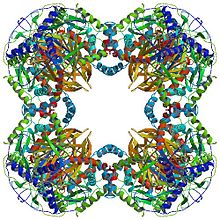
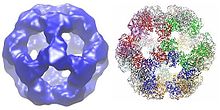
All dihydrolipoyl transacetylases have a unique multidomain structure consisting of (from N to C): 3 lipoyl domains, an interaction domain, and the catalytic domain (see the domain architecture at Pfam). All the domains are connected by disordered, low complexity linker regions.
Depending on the species, multiple subunits of dihydrolipoyl transacetylase enzymes can arrange together into either a cubic or dodecahedral shape. These structure then form the catalytic core of the pyruvate dehydrogenase complex which not only catalyzes the reaction that transfers an acetyl group to CoA, but also performs a crucial structural role in creating the architecture of the overall complex.
Cube
The cubic core structure, found in species such as Azotobacter vinelandii, is made up of 24 subunits total. The catalytic domains are assembled into trimers with the active site located at the subunit interface. The topology of this trimer active site is identical to that of chloramphenicol acetyltransferase. Eight of these trimers are then arranged into a hollow truncated cube. The two main substrates, CoA and the lipoamide (Lip(SH)2), are found at two opposite entrances of a 30 Å long channel which runs between the subunits and forms the catalytic center. CoA enters from the inside of the cube, and the lipoamide enters from the outside.
Dodecahedron
In many species, including bacteria such as Geobacillus stearothermophilus and Enterococcus faecalis as well as mammals such as humans and cows, the dodecahedral core structure is made up of 60 subunits total. The subunits are arranged in sets of three, similar to the trimers in the cubic core shape, with each set making up one of the 20 dodecahedral vertices.
Function
| dihydrolipoyllysine-residue acetyltransferase | |||||||||
|---|---|---|---|---|---|---|---|---|---|
| Identifiers | |||||||||
| EC no. | 2.3.1.12 | ||||||||
| CAS no. | 9032-29-5 | ||||||||
| Databases | |||||||||
| IntEnz | IntEnz view | ||||||||
| BRENDA | BRENDA entry | ||||||||
| ExPASy | NiceZyme view | ||||||||
| KEGG | KEGG entry | ||||||||
| MetaCyc | metabolic pathway | ||||||||
| PRIAM | profile | ||||||||
| PDB structures | RCSB PDB PDBe PDBsum | ||||||||
| Gene Ontology | AmiGO / QuickGO | ||||||||
| |||||||||
Dihydrolipoyl transacetylase participates in the pyruvate decarboxylation reaction that links glycolysis to the citric acid cycle. These metabolic processes are important for cellular respiration—the conversion of biochemical energy from nutrients into adenosine triphosphate (ATP) which can then be used to carry out numerous biological reactions within a cell. The various parts of cellular respiration take place in different parts of the cell. In eukaryotes, glycolysis occurs in the cytoplasm, pyruvate decarboxylation in the mitochondria, the citric acid cycle within the mitochondrial matrix, and oxidative phosphorylation via the electron transport chain on the mitochondrial cristae. Thus pyruvate dehydrogenase complexes (containing the dihydrolipoyl transacetylase enzymes) are found in the mitochondria of eukaryotes (and simply in the cytosol of prokaryotes).
Mechanism
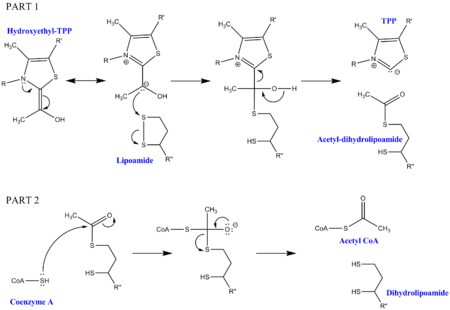
Pyruvate decarboxylation requires a few cofactors in addition to the enzymes that make up the complex. The first is thiamine pyrophosphate (TPP), which is used by pyruvate dehydrogenase to oxidize pyruvate and to form a hydroxyethyl-TPP intermediate. This intermediate is taken up by dihydrolipoyl transacetylase and reacted with a second lipoamide cofactor to generate an acetyl-dihydrolipoyl intermediate, releasing TPP in the process. This second intermediate can then be attacked by the nucleophilic sulfur attached to Coenzyme A, and the dihydrolipoamide is released. This results in the production of acetyl CoA, which is the end goal of pyruvate decarboxylation. The dihydrolipoamide is taken up by dihydrolipoyl dehydrogenase, and with the additional cofactors FAD and NAD+, regenerates the original lipoamide (with NADH as a useful side product).
Interactive pathway map
Click on genes, proteins and metabolites below to link to respective articles.
[[File:

- The interactive pathway map can be edited at WikiPathways: "GlycolysisGluconeogenesis_WP534".
Clinical significance
Primary biliary cirrhosis
Primary biliary cirrhosis (PBC) is an autoimmune disease characterized by autoantibodies against mitochondrial and nuclear antigens. These are called anti-mitochondrial antibodies (AMA) and anti-nuclear antibodies (ANA), respectively. These antibodies are detectable in the sera of PBC patients and vary greatly with regards to epitope specificity from patient to patient. Of the mitochondrial antigens that can generate autoantibody reactivity in PBC patients, the E2 subunit of the pyruvate dehydrogenase complex, dihydrolipoyl transacetylase, is the most common epitope (other antigens include enzymes of the 2-oxoacid dehydrogenase complexes as well as the other enzymes of the pyruvate dehydrogenase complexes). Recent evidence has suggested that peptides within the catalytic site may present the immunodominant epitopes recognized by the anti-PDC-E2 antibodies in PBC patients. There is also evidence of anti-PDC-E2 antibodies in autoimmune hepatitis (AIH) patients.
Pyruvate dehydrogenase deficiency
Pyruvate dehydrogenase deficiency (PDH) is a genetic disease resulting in lactic acidosis as well as neurological dysfunction in infancy and early childhood. Typically PDH is the result of a mutation in the X-linked gene for the E1 subunit of the pyruvate dehydrogenase complex. However, there have been a few rare cases in which a patient with PDH actually has a mutation in the autosomal gene for the E2 subunit instead. These patients have been reported to have much less severe symptoms, with the most prominent disease manifestation being episodic dystonia, though both hypotonia and ataxia were also present.
References
- ^ GRCh38: Ensembl release 89: ENSG00000150768 – Ensembl, May 2017
- ^ GRCm38: Ensembl release 89: ENSMUSG00000000168 – Ensembl, May 2017
- "Human PubMed Reference:". National Center for Biotechnology Information, U.S. National Library of Medicine.
- "Mouse PubMed Reference:". National Center for Biotechnology Information, U.S. National Library of Medicine.
- Leung PS, Watanabe Y, Munoz S, Teuber SS, Patel MS, Korenberg JR, Hara P, Coppel R, Gershwin ME (1993). "Chromosome localization and RFLP analysis of PDC-E2: the major autoantigen of primary biliary cirrhosis". Autoimmunity. 14 (4): 335–40. doi:10.3109/08916939309079237. PMID 8102256.
- Mattevi A, Obmolova G, Kalk KH, Teplyakov A, Hol WG (Apr 1993). "Crystallographic analysis of substrate binding and catalysis in dihydrolipoyl transacetylase (E2p)". Biochemistry. 32 (15): 3887–901. doi:10.1021/bi00066a007. PMID 8471601.
- ^ PDB: 1B5S; Izard T, Aevarsson A, Allen MD, Westphal AH, Perham RN, de Kok A, Hol WG (February 1999). "Principles of quasi-equivalence and Euclidean geometry govern the assembly of cubic and dodecahedral cores of pyruvate dehydrogenase complexes". Proc. Natl. Acad. Sci. U.S.A. 96 (4): 1240–5. Bibcode:1999PNAS...96.1240I. doi:10.1073/pnas.96.4.1240. PMC 15447. PMID 9990008.
- de Kok A, Hengeveld AF, Martin A, Westphal AH (Jun 1998). "The pyruvate dehydrogenase multi-enzyme complex from Gram-negative bacteria". Biochimica et Biophysica Acta (BBA) - Protein Structure and Molecular Enzymology. 1385 (2): 353–66. doi:10.1016/S0167-4838(98)00079-X. PMID 9655933.
- Hanemaaijer R, Westphal AH, Van Der Heiden T, De Kok A, Veeger C (Feb 1989). "The quaternary structure of the dihydrolipoyl transacetylase component of the pyruvate dehydrogenase complex from Azotobacter vinelandii. A reconsideration". European Journal of Biochemistry. 179 (2): 287–92. doi:10.1111/j.1432-1033.1989.tb14553.x. PMID 2917567.
- Mattevi A, Obmolova G, Schulze E, Kalk KH, Westphal AH, de Kok A, Hol WG (Mar 1992). "Atomic structure of the cubic core of the pyruvate dehydrogenase multienzyme complex". Science. 255 (5051): 1544–50. Bibcode:1992Sci...255.1544M. doi:10.1126/science.1549782. PMID 1549782.
- Brautigam CA, Wynn RM, Chuang JL, Chuang DT (May 2009). "Subunit and catalytic component stoichiometries of an in vitro reconstituted human pyruvate dehydrogenase complex". The Journal of Biological Chemistry. 284 (19): 13086–98. doi:10.1074/jbc.M806563200. PMC 2676041. PMID 19240034.
- Zhou ZH, McCarthy DB, O'Connor CM, Reed LJ, Stoops JK (Dec 2001). "The remarkable structural and functional organization of the eukaryotic pyruvate dehydrogenase complexes". Proceedings of the National Academy of Sciences of the United States of America. 98 (26): 14802–7. Bibcode:2001PNAS...9814802Z. doi:10.1073/pnas.011597698. PMC 64939. PMID 11752427.
- Mackay IR, Whittingham S, Fida S, Myers M, Ikuno N, Gershwin ME, Rowley MJ (Apr 2000). "The peculiar autoimmunity of primary biliary cirrhosis". Immunological Reviews. 174: 226–37. doi:10.1034/j.1600-0528.2002.017410.x. PMID 10807519. S2CID 596338. Archived from the original on 2013-01-05.
- Braun S, Berg C, Buck S, Gregor M, Klein R (Feb 2010). "Catalytic domain of PDC-E2 contains epitopes recognized by antimitochondrial antibodies in primary biliary cirrhosis". World Journal of Gastroenterology. 16 (8): 973–81. doi:10.3748/wjg.v16.i8.973. PMC 2828602. PMID 20180236.
- O'Brien C, Joshi S, Feld JJ, Guindi M, Dienes HP, Heathcote EJ (Aug 2008). "Long-term follow-up of antimitochondrial antibody-positive autoimmune hepatitis". Hepatology. 48 (2): 550–6. doi:10.1002/hep.22380. PMID 18666262. S2CID 5400712.
- Head RA, Brown RM, Zolkipli Z, Shahdadpuri R, King MD, Clayton PT, Brown GK (Aug 2005). "Clinical and genetic spectrum of pyruvate dehydrogenase deficiency: dihydrolipoamide acetyltransferase (E2) deficiency". Annals of Neurology. 58 (2): 234–41. doi:10.1002/ana.20550. PMID 16049940. S2CID 38264402.
Further reading
- Mattevi A, Obmolova G, Kalk KH, Teplyakov A, Hol WG (Apr 1993). "Crystallographic analysis of substrate binding and catalysis in dihydrolipoyl transacetylase (E2p)". Biochemistry. 32 (15): 3887–901. doi:10.1021/bi00066a007. PMID 8471601.
- Brady RO, Stadtman ER (Dec 1954). "Enzymatic thioltransacetylation". The Journal of Biological Chemistry. 211 (2): 621–9. doi:10.1016/S0021-9258(18)71152-6. PMID 13221570.
- Gunsalus IC, Barton LS, Gruber W (1956). "Biosynthesis and structure of lipoic acid derivatives". J. Am. Chem. Soc. 78 (8): 1763–1766. doi:10.1021/ja01589a079.
- Perham RN (2000). "Swinging arms and swinging domains in multifunctional enzymes: catalytic machines for multistep reactions". Annual Review of Biochemistry. 69: 961–1004. doi:10.1146/annurev.biochem.69.1.961. PMID 10966480.
- Howard MJ, Fuller C, Broadhurst RW, Perham RN, Tang JG, Quinn J, Diamond AG, Yeaman SJ (Jul 1998). "Three-dimensional structure of the major autoantigen in primary biliary cirrhosis". Gastroenterology. 115 (1): 139–46. doi:10.1016/S0016-5085(98)70375-0. PMID 9649469.
- Matsumura S, Kita H, He XS, Ansari AA, Lian ZX, Van De Water J, Yamamoto K, Tsuji T, Coppel RL, Kaplan M, Gershwin ME (Nov 2002). "Comprehensive mapping of HLA-A0201-restricted CD8 T-cell epitopes on PDC-E2 in primary biliary cirrhosis". Hepatology. 36 (5): 1125–34. doi:10.1053/jhep.2002.36161. PMID 12395322. S2CID 20687454.
- Suzuki Y, Yoshitomo-Nakagawa K, Maruyama K, Suyama A, Sugano S (Oct 1997). "Construction and characterization of a full length-enriched and a 5'-end-enriched cDNA library". Gene. 200 (1–2): 149–56. doi:10.1016/S0378-1119(97)00411-3. PMID 9373149.
- Korotchkina LG, Patel MS (Feb 2008). "Binding of pyruvate dehydrogenase to the core of the human pyruvate dehydrogenase complex". FEBS Letters. 582 (3): 468–72. Bibcode:2008FEBSL.582..468K. doi:10.1016/j.febslet.2007.12.041. PMC 2262399. PMID 18206651.
- Head RA, Brown RM, Zolkipli Z, Shahdadpuri R, King MD, Clayton PT, Brown GK (Aug 2005). "Clinical and genetic spectrum of pyruvate dehydrogenase deficiency: dihydrolipoamide acetyltransferase (E2) deficiency". Annals of Neurology. 58 (2): 234–41. doi:10.1002/ana.20550. PMID 16049940. S2CID 38264402.
- Bogdanos DP, Pares A, Baum H, Caballeria L, Rigopoulou EI, Ma Y, Burroughs AK, Rodes J, Vergani D (Jun 2004). "Disease-specific cross-reactivity between mimicking peptides of heat shock protein of Mycobacterium gordonae and dominant epitope of E2 subunit of pyruvate dehydrogenase is common in Spanish but not British patients with primary biliary cirrhosis". Journal of Autoimmunity. 22 (4): 353–62. doi:10.1016/j.jaut.2004.03.002. PMID 15120760. S2CID 6619201.
- Lleo A, Selmi C, Invernizzi P, Podda M, Coppel RL, Mackay IR, Gores GJ, Ansari AA, Van de Water J, Gershwin ME (Mar 2009). "Apotopes and the biliary specificity of primary biliary cirrhosis" (PDF). Hepatology. 49 (3): 871–9. doi:10.1002/hep.22736. hdl:2434/55031. PMC 2665925. PMID 19185000.
- Bellucci R, Oertelt S, Gallagher M, Li S, Zorn E, Weller E, Porcheray F, Alyea EP, Soiffer RJ, Munshi NC, Gershwin ME, Ritz J (Mar 2007). "Differential epitope mapping of antibodies to PDC-E2 in patients with hematologic malignancies after allogeneic hematopoietic stem cell transplantation and primary biliary cirrhosis". Blood. 109 (5): 2001–7. doi:10.1182/blood-2006-06-030304. PMC 1801041. PMID 17068145.
- Hiromasa Y, Roche TE (Sep 2003). "Facilitated interaction between the pyruvate dehydrogenase kinase isoform 2 and the dihydrolipoyl acetyltransferase". The Journal of Biological Chemistry. 278 (36): 33681–93. doi:10.1074/jbc.M212733200. PMID 12816949.
- Trynka G, Zhernakova A, Romanos J, Franke L, Hunt KA, Turner G, Bruinenberg M, Heap GA, Platteel M, Ryan AW, de Kovel C, Holmes GK, Howdle PD, Walters JR, Sanders DS, Mulder CJ, Mearin ML, Verbeek WH, Trimble V, Stevens FM, Kelleher D, Barisani D, Bardella MT, McManus R, van Heel DA, Wijmenga C (Aug 2009). "Coeliac disease-associated risk variants in TNFAIP3 and REL implicate altered NF-kappaB signalling". Gut. 58 (8): 1078–83. doi:10.1136/gut.2008.169052. PMID 19240061. S2CID 17111427.
- Hiromasa Y, Fujisawa T, Aso Y, Roche TE (Feb 2004). "Organization of the cores of the mammalian pyruvate dehydrogenase complex formed by E2 and E2 plus the E3-binding protein and their capacities to bind the E1 and E3 components". The Journal of Biological Chemistry. 279 (8): 6921–33. doi:10.1074/jbc.M308172200. PMID 14638692.
- Cori CF (1981). "The glucose-lactic acid cycle and gluconeogenesis". Current Topics in Cellular Regulation. 18: 377–87. doi:10.1016/B978-0-12-152818-8.50028-1. ISBN 9780121528188. PMID 7273846.
- Maruyama K, Sugano S (Jan 1994). "Oligo-capping: a simple method to replace the cap structure of eukaryotic mRNAs with oligoribonucleotides". Gene. 138 (1–2): 171–4. doi:10.1016/0378-1119(94)90802-8. PMID 8125298.
- Tuganova A, Boulatnikov I, Popov KM (Aug 2002). "Interaction between the individual isoenzymes of pyruvate dehydrogenase kinase and the inner lipoyl-bearing domain of transacetylase component of pyruvate dehydrogenase complex". The Biochemical Journal. 366 (Pt 1): 129–36. doi:10.1042/BJ20020301. PMC 1222743. PMID 11978179.
External links
- PDB: 1EAA, PDB: 1dpb
- Dihydrolipoyl+transacetylase at the U.S. National Library of Medicine Medical Subject Headings (MeSH)
- Overview of all the structural information available in the PDB for UniProt: P10515 (Dihydrolipoyl transacetylase) at the PDBe-KB.
| Enzymes: multienzyme complexes | |
|---|---|
| Photosynthesis | |
| Dehydrogenase | |
| Other | |
| Glycolysis metabolic pathway | |
|---|---|
 ATP
ADP
ATP
ADP

 ATP
ADP
ATP
ADP


+ +
2 × Glyceraldehyde 3-phosphate 2 ×
Glyceraldehyde-3-phosphate  ADP
ATP
ADP
ATP


Phosphopyruvate  ADP
ATP
ADP
ATP
2 × Pyruvate 2 × |
| Enzymes | |
|---|---|
| Activity | |
| Regulation | |
| Classification | |
| Kinetics | |
| Types |
|




